Costa Rica Tour
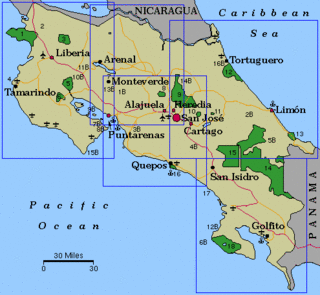 When I returned to Horizons after my month long trip to Costa Rica, the boat was a bit dusty inside, with a little light decorative mould on some of the wood surfaces from the high humidity. But otherwise, all was fine, with no unpleasant surprises. A few dead ants here and there - it's virtually impossible to keep insects off the boat in the tropics, especially the flying varieties. So I have to use the regular killer sprays and powders to keep the little creatures to a minimum.
When I returned to Horizons after my month long trip to Costa Rica, the boat was a bit dusty inside, with a little light decorative mould on some of the wood surfaces from the high humidity. But otherwise, all was fine, with no unpleasant surprises. A few dead ants here and there - it's virtually impossible to keep insects off the boat in the tropics, especially the flying varieties. So I have to use the regular killer sprays and powders to keep the little creatures to a minimum.I enjoyed my month in Costa Rica and feel quite reinvigorated by it. It was just the medicine I needed after several months of being cabin bound here in the marina while I worked on video DVD projects. My starting point was in the capital, San José. I found it to be conside
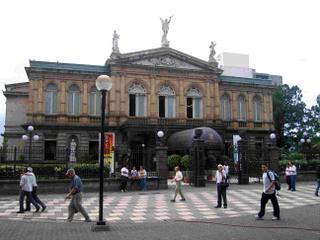 rably cooler in San José than in Puesta del Sol and the coastal areas of Costa Rica. San José is in the Central Valley of the country, where the bulk of the population lives. It's at about 3,600 feet elevation, between two mountain ranges. The day times were quite comfortable - warm but not too hot (probably in the mid to low 20's Celsius most of the time), and no significantly high humidity. At night it was relatively cool - border line short sleeved T-shirt comfort. I had to put my fleece over me when sleeping as it was a bit cool overnight and only a light sheet was provided by my budget hotel.
rably cooler in San José than in Puesta del Sol and the coastal areas of Costa Rica. San José is in the Central Valley of the country, where the bulk of the population lives. It's at about 3,600 feet elevation, between two mountain ranges. The day times were quite comfortable - warm but not too hot (probably in the mid to low 20's Celsius most of the time), and no significantly high humidity. At night it was relatively cool - border line short sleeved T-shirt comfort. I had to put my fleece over me when sleeping as it was a bit cool overnight and only a light sheet was provided by my budget hotel.I saw most of the few attractions of San José, including the interesting National Museum (which also has an exo
 tic butterfly enclosure) and the Gold Museum (no cameras allowed), and later in my visit, the Jade Museum (ditto). One morning I also strolled through the well worn and somewhat tired Botanical Gardens with its small zoo containing a number of aged caged animals, until the predictable mid day deluge had me run for cover. For the best part of a week
tic butterfly enclosure) and the Gold Museum (no cameras allowed), and later in my visit, the Jade Museum (ditto). One morning I also strolled through the well worn and somewhat tired Botanical Gardens with its small zoo containing a number of aged caged animals, until the predictable mid day deluge had me run for cover. For the best part of a week  during the early part of my sojourn, I was nursing a very painful right foot, which was making it very difficult to walk. I was only able get about slowly, with a pronounced shuffle/limp. I had suffered a heavy fall on a visit to the Irazú Volcano, about 1½ hours from San José. I must be getting old and clumsy and turned o
during the early part of my sojourn, I was nursing a very painful right foot, which was making it very difficult to walk. I was only able get about slowly, with a pronounced shuffle/limp. I had suffered a heavy fall on a visit to the Irazú Volcano, about 1½ hours from San José. I must be getting old and clumsy and turned o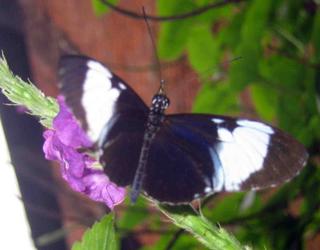 ver my ankle on the edge of the path. I was off balance with my pack and my video camera around my neck, and went crashing hard to the ground. Somehow, I painfully injured my big toe. This put a bit of a crimp in my plans for further exploration for about four or five days, most of which usually involves walking.
ver my ankle on the edge of the path. I was off balance with my pack and my video camera around my neck, and went crashing hard to the ground. Somehow, I painfully injured my big toe. This put a bit of a crimp in my plans for further exploration for about four or five days, most of which usually involves walking.I soon discovered at first hand how much more it rains in Costa Rica in the rainy season compared with Nicaragua and El Salvador. It was partly or totally cloudy for most of the various times I was in San José, except for some occasional short sunny periods in the mornings. By noon, the camera was put away and the
 umbrella was readied. Fortunately, the clouds delayed rolling in for long enough for me to get some good photos of the craters of Irazú Volcano. It's the highest volcano in Costa Rica, at 3432 metres. The Principal Crater is live but dormant (its last eruption was in December, 1994), and has a vividly green lake at the bottom. The other two much older craters are extinct. My video camera seemed to survive my fall, but the motor now sounds noisier than previously. It continued to work throughout the rest of my travels, but I hope that there's no latent damage - especially after all the troubles I had with my previous video camera.
umbrella was readied. Fortunately, the clouds delayed rolling in for long enough for me to get some good photos of the craters of Irazú Volcano. It's the highest volcano in Costa Rica, at 3432 metres. The Principal Crater is live but dormant (its last eruption was in December, 1994), and has a vividly green lake at the bottom. The other two much older craters are extinct. My video camera seemed to survive my fall, but the motor now sounds noisier than previously. It continued to work throughout the rest of my travels, but I hope that there's no latent damage - especially after all the troubles I had with my previous video camera.San José served as my base during my time in Costa Rica. From there, I branched out to different parts of the country, near and not so near (nowhere is far). After Irazú, I visited Poás (2574 metres), another active volcano about 55 Kms from San José. Apparently, it has one of the largest active volcanic craters in the world. It last erupted in 1989, although it's been active since then. Poás is quite demonstrative, with lots of steam, sulphur smell, geysers and moonscape terrain in and around the Principal Crater, which also contains a light yellow sulphurous/acidic, steam covered lake. Got some good clear p
I next went to Puerto Limón, which is quite a rough little town on the Caribbean coast with few
 redeeming features, including the fact that I didn't feel too secure. I pay heed to cautions in my guide book, but I also often get a sense of a place from just walking around. I explored the central part of the town, with its new large concrete unfinished church, as well as the disappointing beach waterfront. But I stayed off the relatively deserted streets at night except to go across the street from the hotel for dinner. The town's one claim to fame
redeeming features, including the fact that I didn't feel too secure. I pay heed to cautions in my guide book, but I also often get a sense of a place from just walking around. I explored the central part of the town, with its new large concrete unfinished church, as well as the disappointing beach waterfront. But I stayed off the relatively deserted streets at night except to go across the street from the hotel for dinner. The town's one claim to fame  is that Columbus landed on a small island just offshore from Puerto Limón on his last voyage. Unlike many other places I visited in Costa Rica, Puerto Limón doesn't seem to get too many foreign tourists other than, inexplicably, some large cruise ships. It's still an active commercial port but gets no yachting traffic. In fact, Costa Rica's Caribbean coast does not lend itself to yachtie traffic.
is that Columbus landed on a small island just offshore from Puerto Limón on his last voyage. Unlike many other places I visited in Costa Rica, Puerto Limón doesn't seem to get too many foreign tourists other than, inexplicably, some large cruise ships. It's still an active commercial port but gets no yachting traffic. In fact, Costa Rica's Caribbean coast does not lend itself to yachtie traffic.From there, after one night, I then took the half hour bus ride south to Cahuita, where there is
 a small National Park. Cahuita has a funky little village next to the park, but once again, I didn't feel very secure there. I suppose having to fend off an attempt on my wallet during a contrived scrum as I was trying to get off the bus didn't enhance my feeling of security. Costa Rica was living up to its reputation for theft and crimes against tourists, given the atmosphere in many places and my general experiences. It's a pity about this reputation, but it creates a very unfortunate mindset.
a small National Park. Cahuita has a funky little village next to the park, but once again, I didn't feel very secure there. I suppose having to fend off an attempt on my wallet during a contrived scrum as I was trying to get off the bus didn't enhance my feeling of security. Costa Rica was living up to its reputation for theft and crimes against tourists, given the atmosphere in many places and my general experiences. It's a pity about this reputation, but it creates a very unfortunate mindset.This reputation is reinforced by the constant warnings everywhere, from those
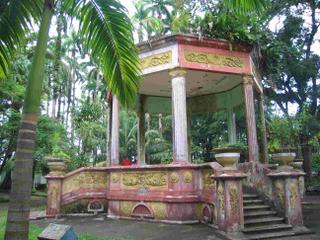 printed in the capital's English language newspaper, on signs in bus stations, inside buses, on the backs of bus tickets and in guide books and other tourist materials, to verbal warnings from hotel concierges and others. Some hotels I stayed at had security gates which required you to be buzzed in. Travelling on the bus to see the Arenal volcano, a security officer told me before the bus left the San José bus station that I had to take my pack down from the overhead rack and put it by my feet where I sat, even though I'd buckled one of the shoulder straps around a rack post. Bus luggage racks are frequent sources of theft. And I've heard stories of the experiences of other cruisers who have had boat equipment, bags, packs and other personal property stolen. I even heard one story of a cruiser whose backpack disappeared from a supposedly safe store paqueteria (a place where you have to check in your bags when entering a store). One evening in San José a restaurant operator recommended that I take a taxi back to my hotel rather than walk. On my way back on foot to my hotel another time, also in San José, I was similarly warned about the risks by a local guy.
printed in the capital's English language newspaper, on signs in bus stations, inside buses, on the backs of bus tickets and in guide books and other tourist materials, to verbal warnings from hotel concierges and others. Some hotels I stayed at had security gates which required you to be buzzed in. Travelling on the bus to see the Arenal volcano, a security officer told me before the bus left the San José bus station that I had to take my pack down from the overhead rack and put it by my feet where I sat, even though I'd buckled one of the shoulder straps around a rack post. Bus luggage racks are frequent sources of theft. And I've heard stories of the experiences of other cruisers who have had boat equipment, bags, packs and other personal property stolen. I even heard one story of a cruiser whose backpack disappeared from a supposedly safe store paqueteria (a place where you have to check in your bags when entering a store). One evening in San José a restaurant operator recommended that I take a taxi back to my hotel rather than walk. On my way back on foot to my hotel another time, also in San José, I was similarly warned about the risks by a local guy. So in Cahuita, I had some concern for security in the Park as I'd also heard some stories of muggings. After assurances of its safety for a lone walker from the park ranger, I did take a morning walk into the Cahuita National Park, which is a typically beautiful and atmospheric Costa Rican tropical rain forest which extends right to the beach. There are lots of various kinds of birds and colourful butterflies such as the big blue Azul Morpho (Morpho Azul?), an amazing variety of flora, and I particularly enjoyed seeing the groups of White Faced Monkeys - everybody's favourite - up in the trees above the trail.
So in Cahuita, I had some concern for security in the Park as I'd also heard some stories of muggings. After assurances of its safety for a lone walker from the park ranger, I did take a morning walk into the Cahuita National Park, which is a typically beautiful and atmospheric Costa Rican tropical rain forest which extends right to the beach. There are lots of various kinds of birds and colourful butterflies such as the big blue Azul Morpho (Morpho Azul?), an amazing variety of flora, and I particularly enjoyed seeing the groups of White Faced Monkeys - everybody's favourite - up in the trees above the trail.After Cahuita, I moved on to Puerto Viejo de Talamanca, a bit further south and not far from the Panamanian border. It was quite a nice, laid back little
 community although a bit touristy. But it felt a bit safer and more secure than in the other two places. It just so happened that it was Carnaval time, and it was very noisy and lively around the little fairground they had erected just above the beach. Took some video of the loud drum beating parade, with the kids doing their repetitive little jump dance. English is spoken by many on the Caribbean coast so it was nice being more easily able to communicate with the locals and the service industry people. And the children, as usual in Central America, were a delight to see. Its much more of an Afro-Carib Rasta and Reggae cultural environment which reminded me of Belize, although there is still a Latin Salsa element ever present.
community although a bit touristy. But it felt a bit safer and more secure than in the other two places. It just so happened that it was Carnaval time, and it was very noisy and lively around the little fairground they had erected just above the beach. Took some video of the loud drum beating parade, with the kids doing their repetitive little jump dance. English is spoken by many on the Caribbean coast so it was nice being more easily able to communicate with the locals and the service industry people. And the children, as usual in Central America, were a delight to see. Its much more of an Afro-Carib Rasta and Reggae cultural environment which reminded me of Belize, although there is still a Latin Salsa element ever present.The road connecting San José with Puerto Limón and Puerto Viejo de
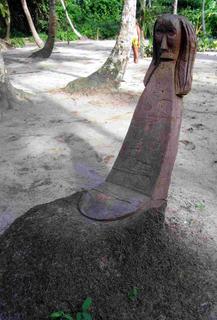 Talamanca on the north coast crosses the continental divide, over the central mountain range, which meant passing through the cloud forests of Braulio Carillo National Park. It was typical high level tropical jungle scenery with plenty of the promised dripping clouds swirling about. Costa Rica is a strikingly beautiful country, lush and green everywhere you go. A bit like British Columbia in the sense that for all this to exist requires a lot of rain. My experiences confirm my advice that December to April or May are the best times of year to see this country, when the precipitation is reduced, particularly in the north and on the Pacific side.
Talamanca on the north coast crosses the continental divide, over the central mountain range, which meant passing through the cloud forests of Braulio Carillo National Park. It was typical high level tropical jungle scenery with plenty of the promised dripping clouds swirling about. Costa Rica is a strikingly beautiful country, lush and green everywhere you go. A bit like British Columbia in the sense that for all this to exist requires a lot of rain. My experiences confirm my advice that December to April or May are the best times of year to see this country, when the precipitation is reduced, particularly in the north and on the Pacific side.After a brief interlude in San José, my next excursion was to the Tortuguero National Park on the north Caribbean coast in the direction of Nicaragua. It's a major turtle nesting area. Large numbers of turtles come ashore at this location to lay their eggs, often several times a year, but not en masse and always after dark. It was interesting gettti
 ng there, as
ng there, as  there are no roads into Tortuguero. The bus goes only so far to the north east about 2 hours from San José, the latter part through large banana plantations (we had to disinfect our shoes at a checkpoint before entering that area), and the final leg of the journey is a fascinating 1½ hour trip by boat down a twisty, bendy river through various kinds of tropical rain forest. We saw large green lizards and a wide variety of small and large tropical birds. Also heard but didn't see the Howler Monkeys. On the early morning return journey we saw a lot of White Faced Monkeys high in the trees crossing the river in front of us by jumping acrobatically from overhanging branches on one side to overhanging branches on the other. We also came upon a crocodile basking in the sun on
there are no roads into Tortuguero. The bus goes only so far to the north east about 2 hours from San José, the latter part through large banana plantations (we had to disinfect our shoes at a checkpoint before entering that area), and the final leg of the journey is a fascinating 1½ hour trip by boat down a twisty, bendy river through various kinds of tropical rain forest. We saw large green lizards and a wide variety of small and large tropical birds. Also heard but didn't see the Howler Monkeys. On the early morning return journey we saw a lot of White Faced Monkeys high in the trees crossing the river in front of us by jumping acrobatically from overhanging branches on one side to overhanging branches on the other. We also came upon a crocodile basking in the sun on  the river bank. As soon as it became aware of us, it slithered into the river in traditional menacing crocodile fashion, ending up with only eyes and nose visible above the water. National Geographic stuff.
the river bank. As soon as it became aware of us, it slithered into the river in traditional menacing crocodile fashion, ending up with only eyes and nose visible above the water. National Geographic stuff.On the day of my arrival in Tortuguero, I took an evening tour to see some turtles on the beach well inside the park area. Our group saw several large Green Turtles (about 6 feet from head to tail) laboriously crawling back to the sea after laying their eggs. We also saw one large turtle in the actual process of laying her eggs in the deep hole she had dug at the top of the beach. The turtles enter a kind of
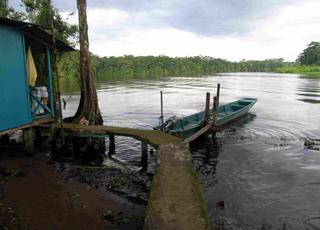 a trance when they are actually laying the eggs and are not conscious of the observers. However, no one was allowed to have white lights, and cameras and flash were not allowed. These would seriously disturb the turtles. But the guides had what they called infrared lights, which seemed to be just low level red lights, so that we could see what was going on without upsetting the turtles. It was a fascinating experience. The following day I walked on the beach adjacent to the village to see the numerous turtle tracks and nests in daylight. Unfortunately, there are lots of natural predators, plus an alarming number of marauding stray dogs and even people,
a trance when they are actually laying the eggs and are not conscious of the observers. However, no one was allowed to have white lights, and cameras and flash were not allowed. These would seriously disturb the turtles. But the guides had what they called infrared lights, which seemed to be just low level red lights, so that we could see what was going on without upsetting the turtles. It was a fascinating experience. The following day I walked on the beach adjacent to the village to see the numerous turtle tracks and nests in daylight. Unfortunately, there are lots of natural predators, plus an alarming number of marauding stray dogs and even people,  which prey on the eggs and baby turtles both inside and outside the protected park area. Apparently, of the many eggs laid, only about 3% of turtles make it to adulthood. The village of Tortuguero, just outside the park, was very relaxed and slow paced and had a nice atmosphere. I took photos and video of different kinds of lizards, butterflies and large strange looking insects when walking just above the beach. Also saw more White Faced Monkeys in the trees behind the beach. It was a good visit.
which prey on the eggs and baby turtles both inside and outside the protected park area. Apparently, of the many eggs laid, only about 3% of turtles make it to adulthood. The village of Tortuguero, just outside the park, was very relaxed and slow paced and had a nice atmosphere. I took photos and video of different kinds of lizards, butterflies and large strange looking insects when walking just above the beach. Also saw more White Faced Monkeys in the trees behind the beach. It was a good visit.
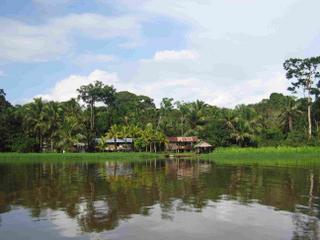 My trip from San José to see the famous Arenal active volcano, near La Fortuna, was not very successful, although the bus ride there was again through some beautiful idyllically scenic countryside and made the trip
My trip from San José to see the famous Arenal active volcano, near La Fortuna, was not very successful, although the bus ride there was again through some beautiful idyllically scenic countryside and made the trip  worthwhile. Same for the return trip which I made via a different route, around Lake Arenal. But I only got to see the lower half of the volcano as there was heavy low overcast at the times when it was not actually raining. There are other attractions in that vicinity, such as rain forest canopy tours, hot springs, horseback riding, nature walks, etc. But all these tours were quite expensive and probably designed for the normal rich, freespending three week holidaymaker from North America. Given the weather, there was not much point in exploring these options anyway. I bypassed the Monteverde National Park on the way back to San José for the same reason. Possibly I'll make another attempt when I have Horizons in Costa Rica.
worthwhile. Same for the return trip which I made via a different route, around Lake Arenal. But I only got to see the lower half of the volcano as there was heavy low overcast at the times when it was not actually raining. There are other attractions in that vicinity, such as rain forest canopy tours, hot springs, horseback riding, nature walks, etc. But all these tours were quite expensive and probably designed for the normal rich, freespending three week holidaymaker from North America. Given the weather, there was not much point in exploring these options anyway. I bypassed the Monteverde National Park on the way back to San José for the same reason. Possibly I'll make another attempt when I have Horizons in Costa Rica.Costa Rica's Independence Day intervened on Sept. 15th (as in other Central
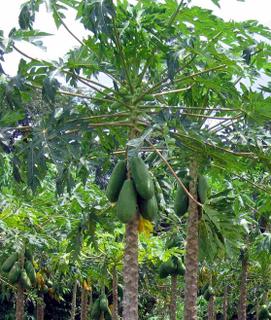 American countries). Lots of flag waving and a big, slow, lumbering noisy parade in the centre of San José. I then headed to the Pacific coast to check out Puntarenas on my way back to Nicaragua. More security concerns in Puntarenas, according to the woman running the hotel where I stayed. But I hiked around anyway and ultimately located the Costa Rica Yacht Club. Talked to the manager and inspected the boat haulout facilities and yard. I also bumped into a cruiser in the club house I'd last seen about 2½ years ago in Mazatlán, Mexico.
American countries). Lots of flag waving and a big, slow, lumbering noisy parade in the centre of San José. I then headed to the Pacific coast to check out Puntarenas on my way back to Nicaragua. More security concerns in Puntarenas, according to the woman running the hotel where I stayed. But I hiked around anyway and ultimately located the Costa Rica Yacht Club. Talked to the manager and inspected the boat haulout facilities and yard. I also bumped into a cruiser in the club house I'd last seen about 2½ years ago in Mazatlán, Mexico.I then continued on back to Nicaragua, where I had an unplanned stopover in
 San Juan del Sur, not far from the border. My bus was late arriving at the connection point in nearby Rivas, Nicaragua, so I had missed the last bus to Granada, which I had wanted to visit for the second time. But it was an enjoyable stopover, as I was able to visit with a Canadian I got to know in El Salvador who lives in San Juan with his Nicaraguan wife and beautiful and delightful children. He's been working on a much needed cruisers' guide for western Central America for the past couple of years but is being a bit slow about getting it to the market. It looks like it will be a very useful book and should help to open up this part of the coast to a lot more cruising boats. I'm looking forward to stopping in San Juan del Sur again, this time with my boat on my way to Costa Rica.
San Juan del Sur, not far from the border. My bus was late arriving at the connection point in nearby Rivas, Nicaragua, so I had missed the last bus to Granada, which I had wanted to visit for the second time. But it was an enjoyable stopover, as I was able to visit with a Canadian I got to know in El Salvador who lives in San Juan with his Nicaraguan wife and beautiful and delightful children. He's been working on a much needed cruisers' guide for western Central America for the past couple of years but is being a bit slow about getting it to the market. It looks like it will be a very useful book and should help to open up this part of the coast to a lot more cruising boats. I'm looking forward to stopping in San Juan del Sur again, this time with my boat on my way to Costa Rica.As I've said, Costa Rica is a strikingly beautiful country - almost a Garden of
 Eden - but I have found that for tourists its main problem is personal security. You have to be on your guard all the time in many places. This was confirmed to me by a Canadian I know who has lived in the country for the past several years. Most of the experienced travellers I met there were very security conscious. In the almost four years I have been in Latin America, I have never felt unsafe or insecure (not counting the incident in Guatemala when I was shot at by banditos) except since arriving in Costa Rica. It's ironic that this should be the case, given its relative wealth compared to other countries in this region. The contrast with the other Central American countries I have visited is that Costa Rica is virtually a First World country whereas those others are clearly Third World. The Central Valley of Costa Rica in particular is highly developed, with a strong American influence. Lots of US franchises and brand names everywhere. But I have to say that I've felt more safe and secure in the places I've visited in El Salvador, Honduras, Nicaragua and even Guatemala (subject to above comment) than in Costa Rica. It really is too bad.
Eden - but I have found that for tourists its main problem is personal security. You have to be on your guard all the time in many places. This was confirmed to me by a Canadian I know who has lived in the country for the past several years. Most of the experienced travellers I met there were very security conscious. In the almost four years I have been in Latin America, I have never felt unsafe or insecure (not counting the incident in Guatemala when I was shot at by banditos) except since arriving in Costa Rica. It's ironic that this should be the case, given its relative wealth compared to other countries in this region. The contrast with the other Central American countries I have visited is that Costa Rica is virtually a First World country whereas those others are clearly Third World. The Central Valley of Costa Rica in particular is highly developed, with a strong American influence. Lots of US franchises and brand names everywhere. But I have to say that I've felt more safe and secure in the places I've visited in El Salvador, Honduras, Nicaragua and even Guatemala (subject to above comment) than in Costa Rica. It really is too bad.When I started my visit, there was a concern at the increasing incidence of dengue fever, a 150% increase over 2004. It's a mosquito borne disease, or two diseases as the rare hemorrhagic form can be fatal very rapidly. There were 14,000 cases of classic and 20 cases of hemorrhagic dengue fever reported up to mid August. It has many symptoms similar to malaria, but unlike with malaria, there is no protective pre-medication for it. I don't like using the stuff, but I bought a bottle of mosquito repellent (although I didn't use it very often).
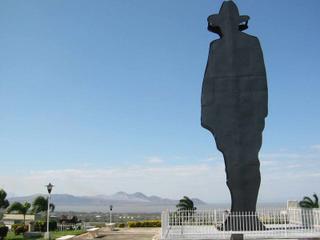 I finally made my way back to the marina from San Juan del Sur via Managua, where I stayed overnight. On the previous times I've stayed overnight in Managua, I've always found a cheap hotel close to the coach line bus stations so that I didn't have to walk far with my backpacks. I've always been conscious of security, as Managua has been getting increasingly unsafe in some areas over the past few years, according to the accepted wisdom. On previous visits, I've gone for walks to nearby places of interest without feeling any discomfort. On this occasion I also went for a walk. I'd passed the new cathedral in the taxi on my way to the hotel, and thought that I'd take a walk to see it. It was about a 30 or 40 minute walk each way. This cathedral was built after the old cathedral near Lake Managua was severely
I finally made my way back to the marina from San Juan del Sur via Managua, where I stayed overnight. On the previous times I've stayed overnight in Managua, I've always found a cheap hotel close to the coach line bus stations so that I didn't have to walk far with my backpacks. I've always been conscious of security, as Managua has been getting increasingly unsafe in some areas over the past few years, according to the accepted wisdom. On previous visits, I've gone for walks to nearby places of interest without feeling any discomfort. On this occasion I also went for a walk. I'd passed the new cathedral in the taxi on my way to the hotel, and thought that I'd take a walk to see it. It was about a 30 or 40 minute walk each way. This cathedral was built after the old cathedral near Lake Managua was severely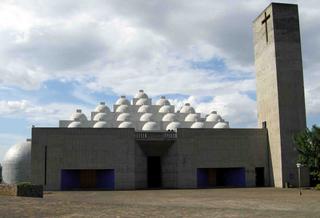 damaged in the devastating earthquake of 1972, which also destroyed most of Managua. This new cathedral looks quite interesting from a distance, with its roof of numerous partial spheres rising in a pattern to a shallow pyramidical peak. But up close, the building is nothing more than a large concrete cube shaped box with little detailing or adornment. I suppose that it's functional, practical and earthquake resistant, and must have been relatively cheap to build. But it's quite ugly, particularly inside. But I'm not a fan of modern concrete churches anyway. I did take several photos on the way to and at the cathedral, discretely. But I didn't feel unsafe during this walk.
damaged in the devastating earthquake of 1972, which also destroyed most of Managua. This new cathedral looks quite interesting from a distance, with its roof of numerous partial spheres rising in a pattern to a shallow pyramidical peak. But up close, the building is nothing more than a large concrete cube shaped box with little detailing or adornment. I suppose that it's functional, practical and earthquake resistant, and must have been relatively cheap to build. But it's quite ugly, particularly inside. But I'm not a fan of modern concrete churches anyway. I did take several photos on the way to and at the cathedral, discretely. But I didn't feel unsafe during this walk.When in San José, I bought a few books at the English language book store. One of those books - praised by Salman Rushdie - was written by a woman, Gioconda Belli, who came from a well to do family in Managua but who became a feminist, poet, author and revolutionary. She joined the Sandinista movement in the years leading up to the overthrow of the dictator Somoza in 1979. I'm still only part way into the book, but it was stimulating to be reading it while I was actually in Managua. Another book I bought was a very well known one in Latin America, The Open Veins of Latin America by Eduardo Galeano. Its subtitle is Five Centuries of the Pillage of a Continent, which gives you a good idea of its theme. The well known author Isabel Allende was influenced by it when she was young, and wrote the Introduction to the edition I bought.
My current plan is to leave the marina in Nicaragua sometime in late October or early November. The rainy season will not yet be over, but I need to get past the Gulf of Papagayo, in northern Costa Rica, before the Papagayo gales start blowing in late November. I will then have to decide on the best time scale regarding hauling out the boat in Puntarenas, Costa Rica, for maintenance work, so as to accommodate the arrival of a visitor over the Christmas period. The anti fouling bottom paint job is not difficult for calculating a time frame. But I've discovered some small blisters in the underwater areas of the fibreglass hull and the time frame for the blister repair job is a bit harder to assess.


3 Comments:
Hello - I thought I'd leave a comment. The site is great - I really should work on mine a bit, instead of just the team blog.
KF
Hi Bob: Hope the winds coming thru Nicaragua do not effect you. Take care. Sheila
Hi Bob:
The photographs of the children are marvellous, especially Mona Lisa. She certainly does leave the real Mona Lisa out in the cold!
Email en route to you....website fantastic. Congratulations!
Love, Carol.
Post a Comment
<< Home